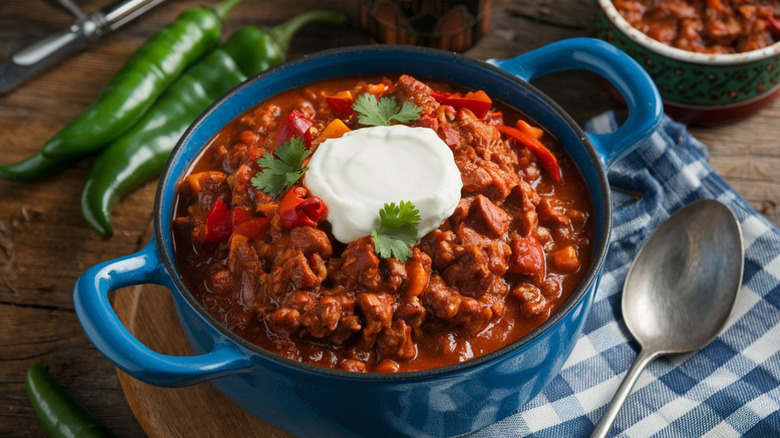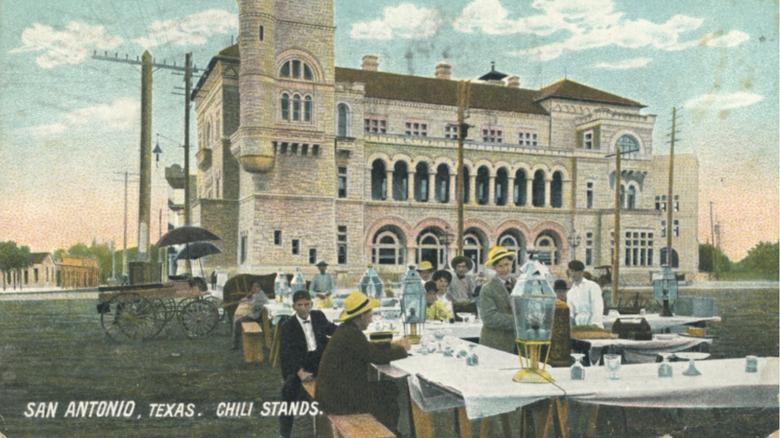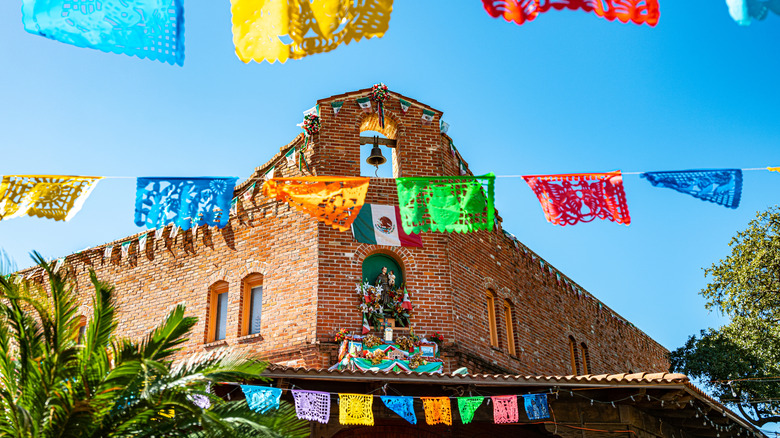The Women Who Brought Chili Con Carne To San Antonio
Eating chili con carne is a right of passage in San Antonio, Texas. The warm, spicy, and filling dish is heaven on a plate, and its origins trace back to the city's Chili Queens. This group of Mexican and Tejana women brought the magic of open-air markets and Tex-Mex cuisine to San Antonio from the 1880s to the late 1940s.
Before Texas became part of the United States in 1845, the territory belonged to Mexico. Changing flags couldn't erase its Mexican legacy, nor could all Mexican people be driven from a land that had previously been theirs. Like many places in Texas, San Antonio continued to have a large population of people who were Mexican-born or who had Mexican heritage, including the women who would become the Chili Queens. As the city grew, it began drawing in various types of people, including bankers, travelers, merchants, and cowboys. Though they seemed complete opposites, these groups all had something in common: They needed to eat. For the business-savvy Chili Queens, this presented a great economic opportunity.
At first, the women sold food during festivals, but as their popularity grew, they began setting up daily stands in places like Market Square and Military Plaza. They would haul in supplies and ingredients in donkeys or carts, set up mesquite wood fires, and begin cooking. The dishes they offered included Mexican staples like tamales and enchiladas, but new dishes started appearing as well. Of these, chili con carne was by far the most popular.
Gaining national attention — and backlash
The food markets that the Chili Queens set up soon became more than places to get a quick and cheap bite. As crowds gathered, so did musicians and other performers who put on shows in the hopes of getting tips. Others would read the news out loud to keep those with no formal education in the loop. Politicians would sometimes meet there to conduct public debates. The stalls became centers of social life, where people of all races and social classes could gather to eat, hear music, and, on occasion, talk to each other.
Word about the queens and their markets began to spread around the country in the late 19th century, especially after the railroad made it easier for people to travel to San Antonio. By this time, the city's two main attractions were the Alamo and the Chili Queens. But not all attention was positive. Though many came for the food, some travelers were drawn in by exoticized images of the Queens. The common, uninformed image of Mexico was that of a wild and dangerous place, and getting close to these women while eating their spicy food was a way to get close to that fantasy. Even worse, since Mexico was often seen as undeveloped and dirty, critics of the food stalls began to complain about the sanitation of these unregulated food stalls. After decades of tension with the local government, the chili stands dwindled and eventually disappeared by the early 1940s.
The Chili Queens' lasting legacy
The government may have forced the Chili Queens out of the markets, but their memory lingers on in San Antonio. Seven decades after the last of the stands shuttered, their legacy remains stronger than ever. Many dishes that we now consider Tex-Mex classics (like chili con carne) can be traced back to the ingenuity of these women. Chili has been the official state dish of Texas since 1977, and the ongoing debate about the one unbreakable rule of Texas chili (beans or no beans) comes from how the Queens served it. San Antonio's love of food trucks and fusion cuisines also comes in part from the Queens' market traditions. Market Square, which once hosted the chili stands, continues to be a place where people gather to shop, eat Tex-Mex, and listen to music.
The Chili Queens' influence has spread beyond Texas: Places like Cincinnati, Ohio now having their own version of the dish. And any home cook who's ever served chili (or thought of new ingredients to make the recipe more exciting) can thank these hard-working women for the inspiration. That said, San Antonio is still the best place to eat a hot bowl of chili. If you visit the city, make sure to stop at Casa Rio, which claims to use the Chili Queens' original chili con carne recipe, or try the Chili Queens-inspired chili at Four Brothers. Better yet, go to both as a (delicious) way to honor the Queens' memory.


